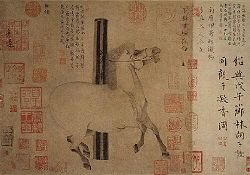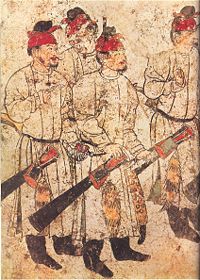
Tang Dynasty painting
Encyclopedia

Tang Dynasty
The Tang Dynasty was an imperial dynasty of China preceded by the Sui Dynasty and followed by the Five Dynasties and Ten Kingdoms Period. It was founded by the Li family, who seized power during the decline and collapse of the Sui Empire...
, as a golden age in Chinese civilization, Chinese painting
Chinese painting
Chinese painting is one of the oldest continuous artistic traditions in the world. The earliest paintings were not representational but ornamental; they consisted of patterns or designs rather than pictures. Early pottery was painted with spirals, zigzags, dots, or animals...
developed dramatically, both in subject matter and technique. The advancements in technique and style that characterized Tang Dynasty painting had a lasting influenced in the art of other countries, especially in East Asia
East Asia
East Asia or Eastern Asia is a subregion of Asia that can be defined in either geographical or cultural terms...
(Korea
Korea
Korea ) is an East Asian geographic region that is currently divided into two separate sovereign states — North Korea and South Korea. Located on the Korean Peninsula, Korea is bordered by the People's Republic of China to the northwest, Russia to the northeast, and is separated from Japan to the...
, Japan
Japan
Japan is an island nation in East Asia. Located in the Pacific Ocean, it lies to the east of the Sea of Japan, China, North Korea, South Korea and Russia, stretching from the Sea of Okhotsk in the north to the East China Sea and Taiwan in the south...
, Vietnam
Vietnam
Vietnam – sometimes spelled Viet Nam , officially the Socialist Republic of Vietnam – is the easternmost country on the Indochina Peninsula in Southeast Asia. It is bordered by China to the north, Laos to the northwest, Cambodia to the southwest, and the South China Sea –...
) and central Asia
Central Asia
Central Asia is a core region of the Asian continent from the Caspian Sea in the west, China in the east, Afghanistan in the south, and Russia in the north...
.
Early period


Sui Dynasty
The Sui Dynasty was a powerful, but short-lived Imperial Chinese dynasty. Preceded by the Southern and Northern Dynasties, it ended nearly four centuries of division between rival regimes. It was followed by the Tang Dynasty....
. In this period, the "painting of people" (人物画) developed greatly. Buddhist painting and "court painting" played a major role, including paintings of the Buddha, monks, nobles etc.
Brothers Yan Liben
Yan Liben
Yan Liben , formally Baron Wenzhen of Boling , was a Chinese painter and government official of the early Tang Dynasty. His most renowned work is the Thirteen Emperors Scroll...
(阎立本) and Yan Lide (阎立德) were among the most prolific painters of this period. Yan Liben was the personal portraitist to the Emperor Taizong
Emperor Taizong of Tang
Emperor Taizong of Tang , personal name Lǐ Shìmín , was the second emperor of the Tang Dynasty of China, ruling from 626 to 649...
. Some of his more notable works include Emperor Tang Taizong Meeting Tibetan Emissaries (太宗步辇图) and Emperors of Previous Dynasties (历代帝王图).
Mid & Late period
The landscape (shan shuiShan shui
Shan shui refers to a style of Chinese painting that involves or depicts scenery or natural landscapes, using a brush and ink rather than more conventional paints. Mountains, rivers and often waterfalls are prominent in this art form.-History:...
) painting technique developed quickly in this period and reached its first maturation. Li Sixun (李思训) and Li Zhaodao (李昭道) (father & son) were the most famous painters in this domain.
The painting of people also reached a climax. The outstanding master in this field is Wu Daozi
Wu Daozi
Wu Daozi was a Chinese artist of the Tang Dynasty, famous for initiating new myths in his artwork.The myth follows the creation by Wu Daozi of a mural commissioned by Emperor Xuanzong of Tang China...
(吴道子), who is referred to as the "Sage of Painting".
Wu's works include God Sending a Son (天王送子图). Wu created a new technique of drawing named "Drawing of Water Shield" (莼菜描).
The great poet Wang Wei
Wang Wei
Wang Wei , was a Tang Dynasty Chinese poet, musician, painter, and statesman. He was one of the most famous men of arts and letters of his time. Many of his poems are preserved, and twenty-nine were included in the highly influential 18th century anthology Three Hundred Tang Poems.-Name...
(王维) first created the brush and ink painting
Ink and wash painting
Ink and wash painting is an East Asian type of brush painting also known as ink wash painting. Only black ink — the same as used in East Asian calligraphy — is used, in various concentrations....
of shan-shui, literally "mountains and waters" (水墨山水画). He further combined literature, especially poetry, with painting. The use of line in painting became much more calligraphic than in the early period.
The theory of painting also developed, and Buddhism, Taoism, and traditional literature were absorbed and combined into painting. Paintings on architectural structures, such as murals (壁画), ceiling paintings, cave paintings, and tomb paintings, were very popular. An example is the paintings in the Mogao Caves
Mogao Caves
The Mogao Caves or Mogao Grottoes , also known as the Caves of the Thousand Buddhas , form a system of 492 temples southeast of the center of Dunhuang, an oasis strategically located at a religious and cultural crossroads on the Silk Road, in Gansu province, China...
in Xinjiang during this period.

